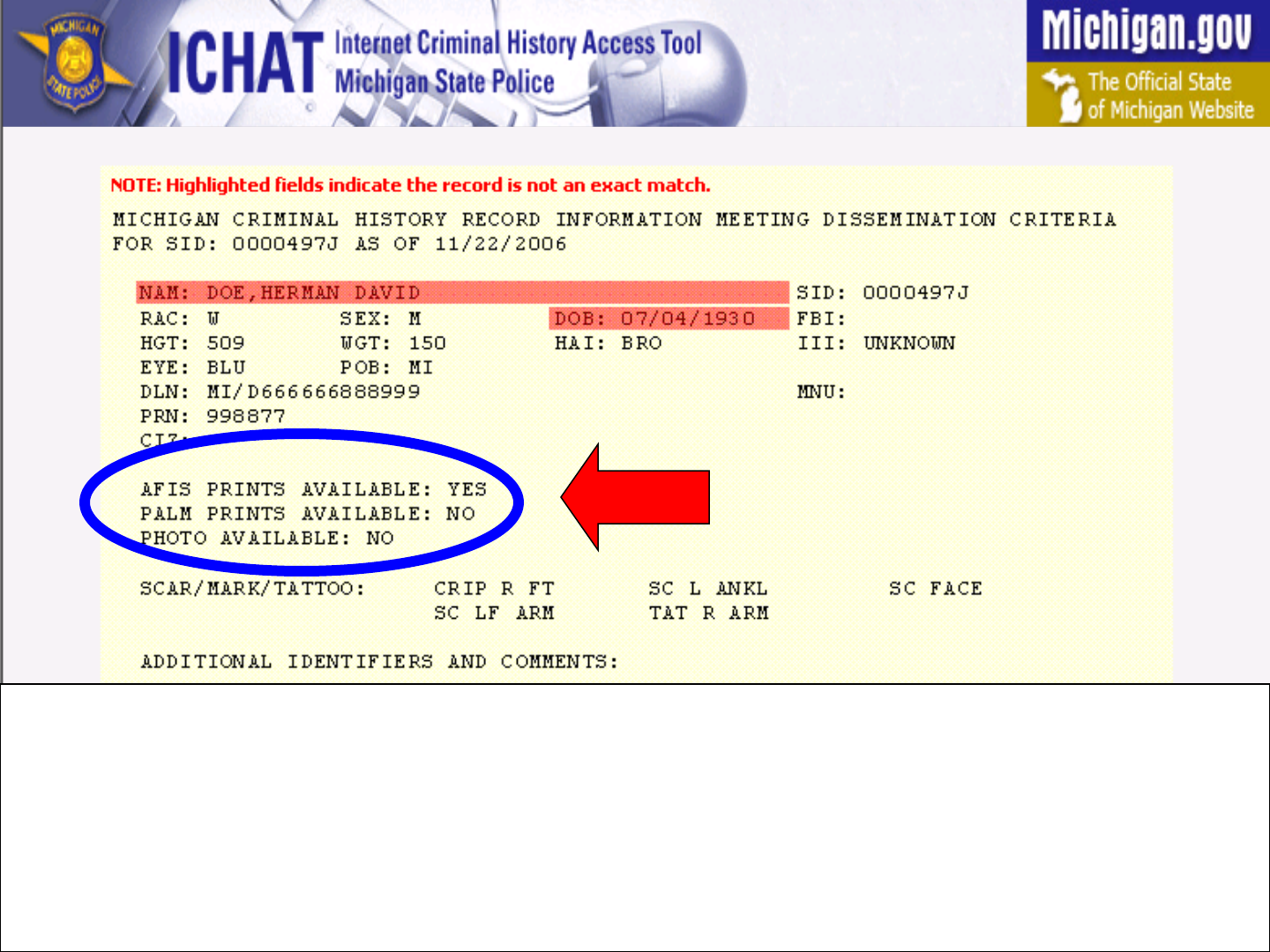
HOW TO READ A
MICHIGAN
CRIMINAL HISTORY
tutorial

The Michigan State Police
provides criminal history
information to the general
public through the ICHAT
system and through
fingerprint-based searches.

The Michigan State Police begin to
build a criminal history for an
individual when arrest fingerprints
are submitted. Later, information
from prosecutors and courts are
entered into the criminal history
records.

Some Common criminal history
terms are:
AFIS – Automated Fingerprint Identification System
CTN – Criminal Tracking Number
DISP – Disposition
FBI – Federal Bureau of Investigation
III – Interstate Identification Index
MCL – Michigan Compiled Laws
OCA – Originating Agency Case number
Ordinance Violation – A violation of local (not state) law
ORI – Originating Agency Identifier
PFI – Pending Further Investigation
PRN – Prison Number
SID – State Identification Number
SMT – Scars, Marks, and Tattoos

The first thing you may notice is the
phrase “meeting dissemination criteria”.
This refers to information that we are
legally allowed to give out.

Next you will notice the SID number.
This is the State Identification, or
criminal record, number assigned to a
particular criminal history record.

If the search was performed on the
ICHAT system, any information in the
identifiers that does not match what
was entered will be highlighted on the
criminal history record

The personal identifiers (as shown in
the circled area) are based on the
information obtained at the time of
arrest.

The FBI space refers to the federal
criminal record number (if any). The III
space refers to the Interstate
Identification Index.

The III space will have one of three phrases:
•Multi-State – meaning a federal record contains
criminal history from more than one state.
•Michigan-Only – meaning the federal record is
the same as the Michigan record.
•Unknown – a Michigan record that was not sent
to the FBI because it did not meet the FBI
retention policies.

This circled area refers to information
obtained at the time of arrest. It is not
available to the general public.

This circled area refers to comments and other identifiers
that the person on the record is known to have used.
Criminal history searches can also match on this information.

The Criminal Tracking Number refers to
the number assigned to that particular
criminal case; the Incident Date refers
to the date the crime occurred; and the
Name Used refers to the name that the
person gave the police at the time of
arrest.

The arrest segment will contain information
about the arrest provided by the arresting
agency. DISP refers to what happened to
the case after it left the arresting agency;
the phrase “warrant requested” means that
the arresting agency requested a charge
warrant from the prosecutor, not that the
person has an outstanding warrant.

The charge segment will contain
information about the criminal charges
provided by the prosecutor for that
case. The charges brought before the
court may be different from the arrest
charges.

The judicial segment will contain information
about the conviction and sentence and is
provided by the court. F/C/R refers to fines,
costs, and restitution; PROB refers to
probation; and CONF refers to jail/prison
time in years (Y), months (M), and days (D).

Court Dispositions
Not Guilty
Found Guilty
Pled Guilty
Nolo Contendre (no contest) – no admittance of guilt, but
accepts court punishment
Deferred – court ordered action, if met then judgment is
dismissed and the incident becomes non- public
Bench Warrant – Arrest warrant issued by the judge for
failure to appear in court

If any information is missing from a
criminal history segment, the phrase
“No Data Received” is displayed.

If you have any questions about the
information in the arrest, charge, or
judicial segment, please contact the
submitting agency.

